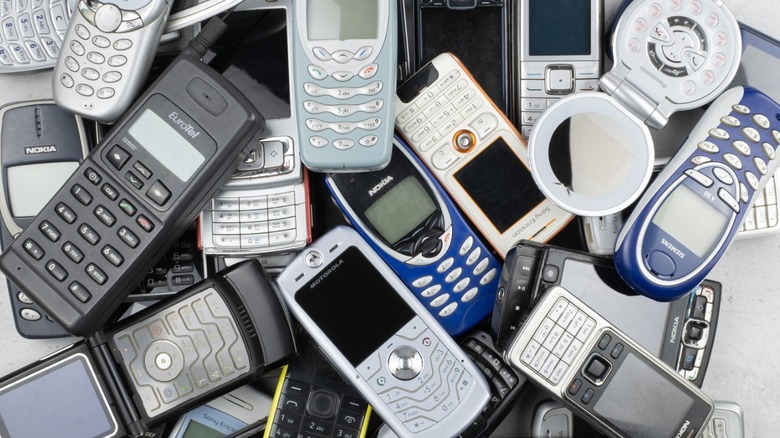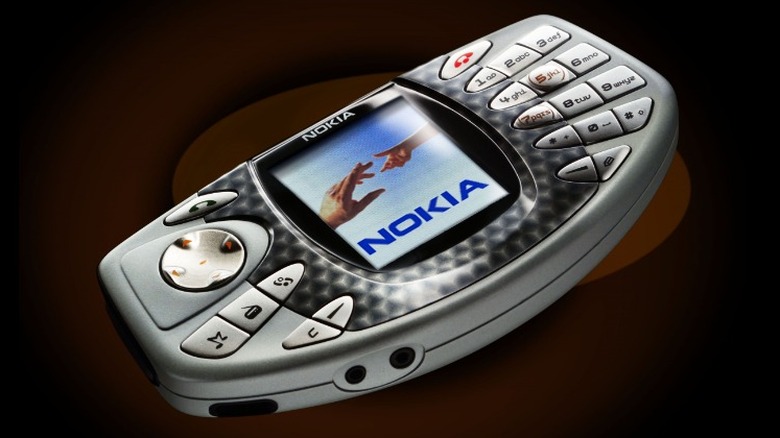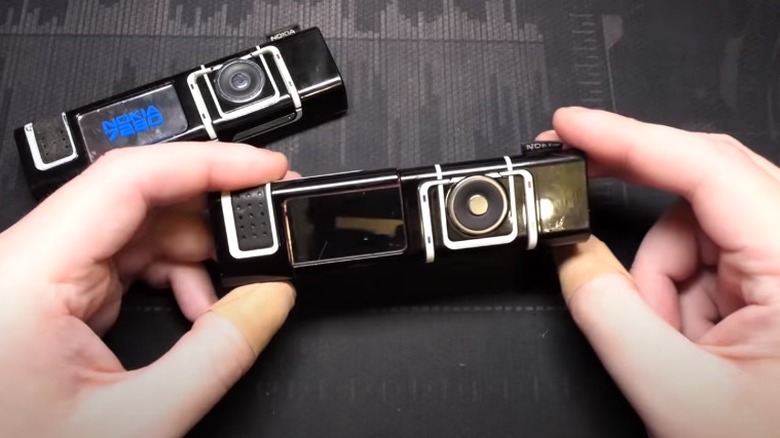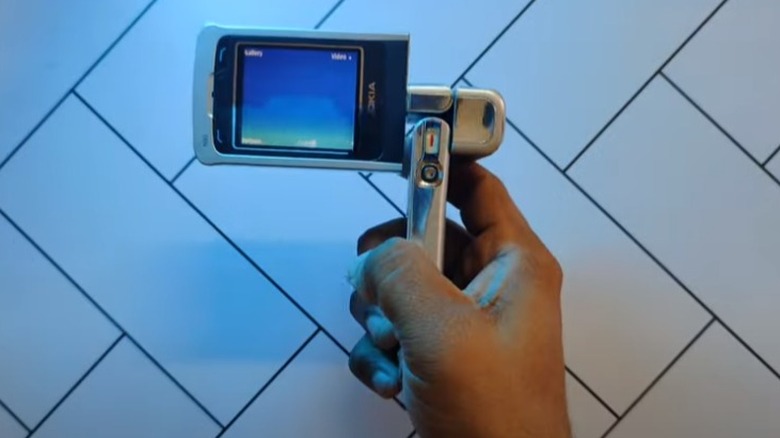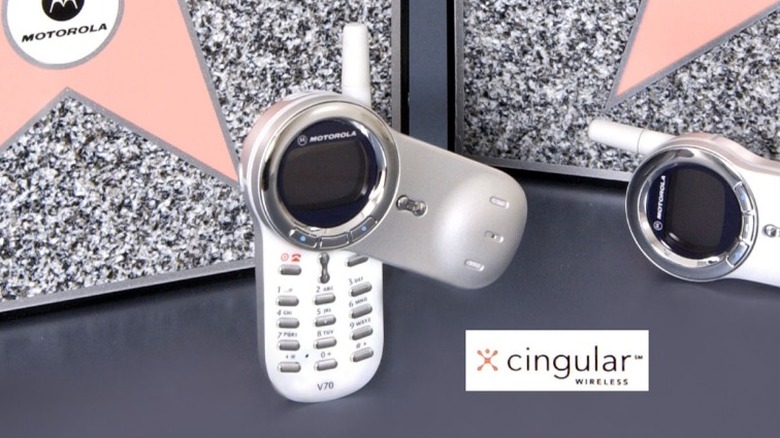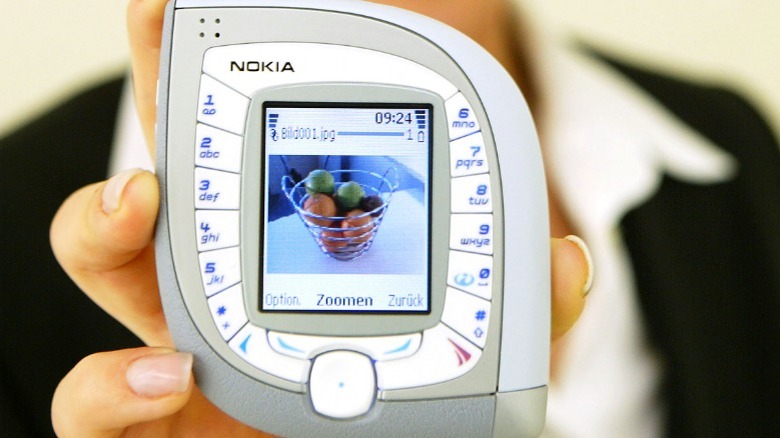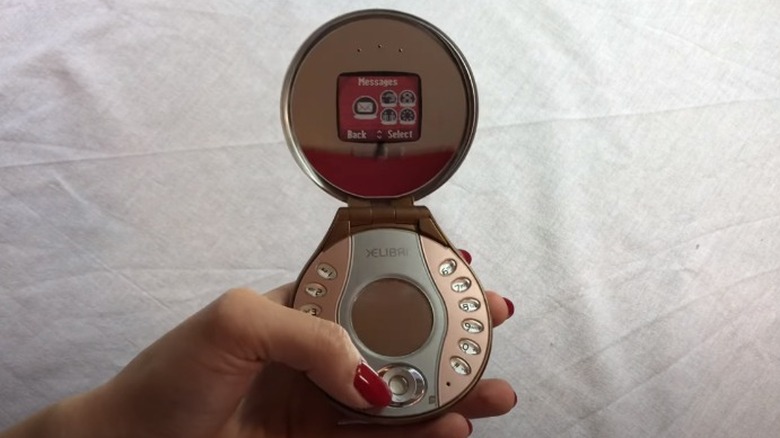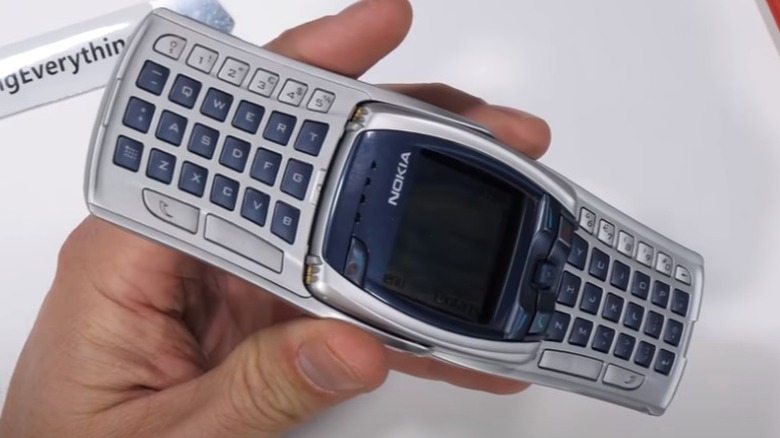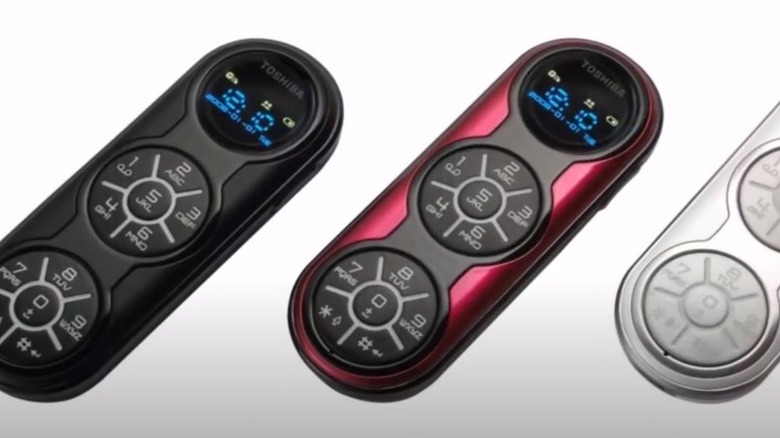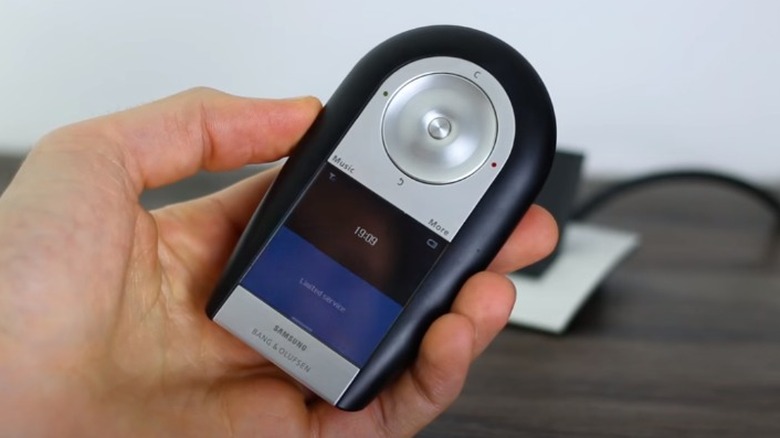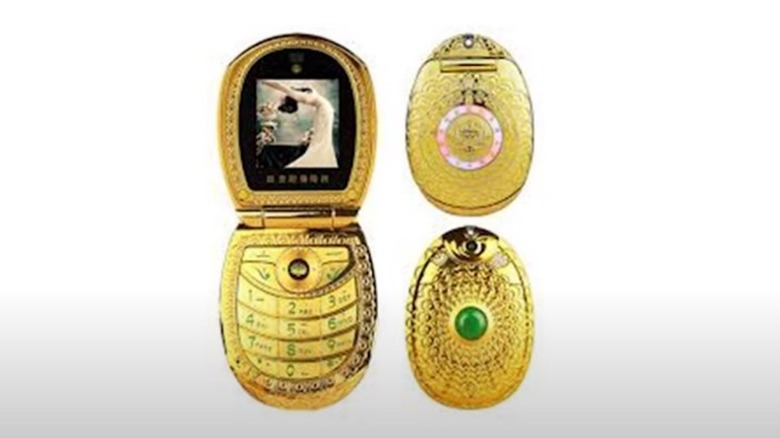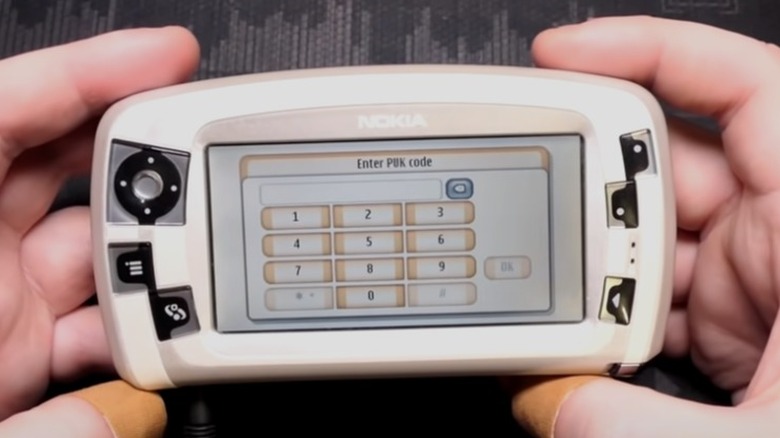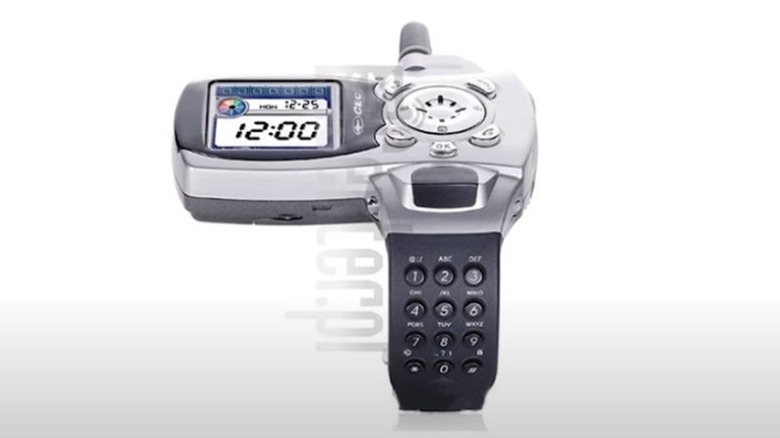12 Bizarre Phones From The 2000s You May Not Remember
After the turn of the millennium, phones became more than just brick-sized plastic boxes with buttons, a mic, and speakers. Zack Morris's Motorola DynaTac had given way to the smaller and less cumbersome phones of the likes we would see used by Scully and Mulder throughout the '90s, and the new millennium had a bunch of technology on tap to change our lives in fundamental ways our '90s brains could not yet comprehend.
The iPhone and the Android operating system that followed ushered in the era of the smartphone that led to modern phone stores carrying various brands of what is essentially the same thing. The biggest differences between models lie underneath the screen and within the software itself, with the exterior portions of the phones consisting of a glass screen and no more than three buttons. Features of operating systems can vary wildly and capabilities can also be vastly divergent, but the basic structure and form of all modern phones are roughly the same.
This could not be said of phones in the early part of the millennium when cellular technology had finally come down in price such that mobile phones were no longer accessible only to country club members with BMWs. However, in an effort to be everything to everyone, some companies came up with pretty bizarre ways of packing in style and features. Here are 12 of the bizarre phones from the 2000s you may have forgotten about.
Nokia N-Gage (2004)
Nokia was a pioneer in the mobile phone market and some of its early devices had become well known for their indestructible qualities, with many jokes existing about them being able to outlast civilization itself. By 2004, the mobile market was well diversified, and so many consumers were entering the market that manufacturers were working hard to offer something to differentiate their products from others. Likewise, video game technology had advanced significantly from the days of Atari and NES, with second and third-generation consoles being available along with newer and better handheld gaming devices. It should seem only natural to merge the technologies, so Nokia did just that.
The N-Gage was a cellular device and gaming device in a single package. Nokia was trying to capitalize on two established markets, creating a niche that would draw in customers in the area in which they fit into both. The N-Gage specs were decent, according to CNET, with Bluetooth, internet capability, expandable memory, an MP3 player, and a full-color display. The N-Gage had some of the right ingredients for a successful product. However, it was $300 and the games had to be purchased separately. With competition from Sony and Nintendo for the limited handheld gaming dollars, Nokia lost the battle, even if it won at "Call of Duty."
Nokia 7280 (2004)
Finnish company Nokia was hugely successful during this time and it produced so many different phones that it gets an outsized representation in this list. The Nokia 7280 was among a number of phones marketed as fashion accessories as much as they were communication devices. This one in particular was targeted toward a specific audience as its design mimics that of a lipstick case. Slightly larger and sharing the rectangular shape of lipstick, the 7280 was also wholly impractical.
Despite the odd packaging, the phone came with a color screen, Bluetooth capability, camera, and internet connectivity, per Mobile Tech Review. It also featured voice command and voice dialing, which is a good thing since it lacked a keypad. All functions of this little weird phone were accomplished with a click wheel and a couple of buttons. It also opened up by pulling on both sides to expose the screen and camera similar to an old spy camera from the films. Although this little device was trendy and clever, it didn't last long for obvious reasons, as people tend to prefer their phones to work well far more than they care about how they look as a fashion accessory.
Nokia N90 (2005)
Another Nokia with a novel approach to functionality is the N90. This phone may be weird by today's standards, but it was incredibly innovative for its time and offered photo and video functions that excelled where ordinary phones could not come close. Phones of this period often chose to focus on a particular capability, whether that was messaging, easy calling, or photography. Nokia also contracted with storied camera manufacturer Carl Zeiss to develop the optics for many of its phones, including the N90.
The N90 phone appeared like any other flip phone upon first examination, but it becomes clear quickly that it had a few unique features. It opened up like a flip phone, but the keypad could then be rotated as well as a slim portion at the hinge that contained a lens. This put the phone in a position to record videos and simulated the form of many camcorders of the time. With its 41MP optics and SD card storage, the N90 would be capable of capturing video at a moment's notice with good clarity compared to other available devices at the time, according to Tech Radar. Today, it is an oddity as modern phones have surpassed its capabilities in myriad ways, but it still stands out as a testament to the creative thinking going on at Nokia back in the day.
Motorola V70 (2003)
Though Nokia looms large in the world of weird phones, Motorola was a pioneer of the technology and not immune from coming up with some goofy designs while the younger Bush was in office. A good example of this is the V70 from 2003. By the end of the '90s, the flip phone had become the standard of high-end devices until smartphones supplanted them. Always wanting to differentiate its product and have something to grab attention, all the phone makers tried different ways to get their flip phones to stand out. With Motorola's V70, it turned the flip concept 180 degrees, literally.
The Motorola V70 featured a fairly large round display screen on the upper portion of the phone with an oblong-shaped cover over the keys. Instead of flipping the device open, the covering over the keys would rotate 180 degrees around the screen to leave you with a full-length phone with a speaker now sitting high on top of the phone and with the keypad uncovered. The purpose of this mechanism was merely to be eye-catching and sell phones, as the rest of its features were similar to others of a similar price, which was a relatively high $400, per CNET. More surprisingly, Motorola brought this design back several years later in an ultra-luxury device clad with a stainless-steel outer shell and exposed swivel gears for the absurd retail price of nearly $2,000. As the iPhone had already been released, this one was not long for this world.
Nokia 7600 (2003)
For many years, the style of phone that Nokia was best known for was called the candy bar phone. Yet, the company released a phone in 2004 called the 7600 that more resembles a Klondike Bar due to its bizarre square-like shape. The 7600 was a big deal for the company at the time as it would be the first to offer 3G connectivity, per The Vooner. Because of this, it came with a relatively large color screen to take full advantage of its wireless capabilities. However, this screen came at the expense of a normal keypad layout.
With a screen centered on the phone, the keys were flanked on either side in strips with 1-5 on the left and 6-0 on the right. A D-pad on the bottom with a couple of additional soft buttons allowed menu navigation. Everything about this layout was strange and far from user-friendly. It appeared to be made as if to be a media streaming device, but came around five years too early and with a screen half as large as necessary. This one came out at a time when it seemed like Steve Jobs was working to make products with clean designs that were intuitive and easy to use, and Nokia just threw weird ideas against a wall and then actually made them.
Siemens Xelibri 6 (2003)
German company Siemens has been in existence for more than a century, making a variety of industrial and consumer products including electronics, locomotives, and even an electric car. Siemens also played a hand in the mobile phone market during this period of innovation with a few decent models on the market. In 2003, the company thought it would be a good idea to release a range of stylish phones marketed toward an upscale audience, and that gave us the undeniably odd and terrible Xelibri 6.
Looking at this phone through a modern lens, one has to question whether it was meant as a joke, despite knowing that it was once sold in real stores — high fashion jewelry stores only. Its form factor was circular and it flipped open like a makeup mirror. Indeed, it even had a pair of mirrors once you got it open. This was a clear case of style before function. GSM Arena lists the specifications, but they don't really matter as it could be filled with Play-Doh and be just as useful. The lower mirror sat in such a way that the keys were inexplicably split into rows on either side. It's evident the target market Siemens was going for by making it look like it should be at home in a cosmetic bag. However, despite an obvious attempt to market this towards women, it came off looking more like a birth control dispenser instead. According to YouTuber MrMobile, this line of phones helped end Siemens' foray into the mobile market for good.
Nokia 6810 (2002)
Text messaging was first developed in the early '90s and proved to be a convenient way to convey information to another cellular device user. This was made more efficient a bit later with the development of T9 predictive text, per Mobivity. Phones by the 2000s almost all included T9, and text messages quickly grew into one of the most popular ways to communicate. Still, it could prove to be a frustrating way to get that communication out because of the limitations of the nine keys available to type 26 characters. Phone companies early on worked to alleviate these concerns, and Nokia did so with the 6810.
Released around 2004, the Nokia 6810 looked like most other phones from its time at first glance. It had a monochrome screen and a typical keypad with the requisite soft buttons for menu navigation. But, hid a party trick behind its keypad ... a keyboard. Lifting on the bottom of the phone revealed a hinged section that folded out to reveal a full qwerty keyboard bisected by the screen, now rotated 90 degrees. This allowed users to use the familiar keyboard layout to quickly write messages without the hassle of using T9 text. This also introduced the idea of thumb typing as the layout was only useful in that manner. Mobile-Review said at the time the cost was close to $500, so it probably did not sell tremendously well as that would have been on the high end of phone prices of the day.
Toshiba G450 (2008)
Toshiba has long been known for making electronics such as TVs and computers, but this company also got into the mobile phone market for a time when it seemed anyone could make money doing it. Many of its products were relatively normal phones, but in 2008, the G450 arrived on the market. In a market saturated with too many companies making too many products, it is important to stand out and get noticed. Unfortunately for Toshiba, the engineers overlooked the importance of retaining a good user experience.
While the G450 was eye-catching, it was obviously odd-looking. It appeared to be constructed with no right angles and built upon a circular theme. Arranging numbers in a circle is nothing new for the telephone, it just stopped being a necessity when dialing went digital. This left the G450 with two circles of numbers splitting the keys from 1-6 on top and the rest in a circle below. Therefore, any familiar number for which you may have muscle memory of the dialing pattern is thrown out, and users had to put in extra thought to dial a number they may have been using for a decade. There is a reason why they say there's no reason to reinvent the wheel. Also, according to CNET, the screen was tiny and it lacked Bluetooth. This was in 2009 when it would be on sale in stores that also offered iPhones and Android devices.
Bang & Olufsen Serenata (2007)
Danish firm Bang & Olufsen is a manufacturer of high-end audio components and is generally well-regarded in the world of high-fidelity audio. In addition to making a variety of consumer products, the company has also been contracted to create audio solutions with other manufacturers, such as automobile companies. The company worked with Samsung to release a mobile phone with an emphasis on high-quality audio, the Serentata.
The product that came out of this partnership was odd. It was a mobile phone but included no keypad in the design and all functions were handled by a control wheel and a couple of touch-sensitive buttons. Stuff reviewed this back in 2007, noting that it did not have the feel of a premium product with its rubber and metal exterior. However, the speaker sounded pretty good and achieved impressive clarity. Its 4GB of storage was competitive at the time, but its lack of a keypad made it almost unusable as a phone. Regardless of how well it recreated any music, the £1,000 price made it feel like nothing more than a cash grab foisted upon easily duped audio snobs.
C91 Golden Buddha (2009)
Phone manufacturers in this period adapted phones for a variety of purposes from making a dedicated media device to a fashion accessory. But not too many of them likely considered making a phone meant to serve religious purposes. That is where the C91 Golden Buddha is set apart as the only phone with an aesthetic suitable for the path to enlightenment.
Information on this phone is hard to come by, but Softpedia News says that it came with a 2.0-inch display, MP3 player, 1.3MP camera, and Bluetooth. The most prominent features of this device were the circular shape, gold plating, and prominently displayed Eastern swastika in the middle of the dial. There was a lotus flower on the case and a Golden Buddha statue as the display background. Tech Gadgets India also reported the phone could be bought at the time for just $123, but did not comment on how it fits into observing the Four Noble Truths.
Nokia 7710 (2004)
Nokia was very busy in the middle part of this decade as it seems that most of these phones came out around 2004, including the 7710, an early smartphone. This model was among the earliest phones to ditch the physical keyboard in favor of one displayed on-screen. It also integrated many of the latest multimedia software packages of the day and its hardware was optimized for this use. It appeared to be another of Nokia's innovative approaches to expanding mobile phone capabilities, but it fell short and did not last.
Without a physical keyboard or keypad, users were forced to rely on the touch screen. That is all well and good today, but this touch screen could only be operated with a stylus. This limited the phone's usefulness significantly and made for a clunky and slow calling process. Trusted Reviews lists some features of the phone including the touch screen along with Bluetooth, camera, FM radio, MP3 player, and a set of built-in apps for productivity and multimedia. It lacked WiFi and videos played via RealPlayer, an industry standard of the time, and were of poor quality. Again, this device tried to do too much too soon, and the problems inherent to the 7710 would be worked out a few years down the road when Apple introduced the iPhone.
Telsom TWC-1150 (2004)
Apple may have debuted the Apple Watch in 2015, but it was far from being the first company to add technology to the tried and tested wristwatch design. Casio is well known for its innovative calculator watch, the fashion accessory of geeks for decades, and Seiko once made a watch with an integrated TV screen.
Reporting in 2004, Engadget covered this curious device, stating that it came with a CDMA phone with a mini numerical keypad, color LCD, and speakerphone in an interesting wristwatch format. As cameras were fast becoming a standard part of every mobile phone on the market at the time, this offered it as a plug-in accessory as well as a "finger-phone," although no further description of that is offered. To avoid having to constantly talk like a Secret Service agent with a wrist up to your ear, it also came with an infrared wireless earpiece. The bulk of this device made it completely impractical and would instantly brand its users as king of the nerds.
